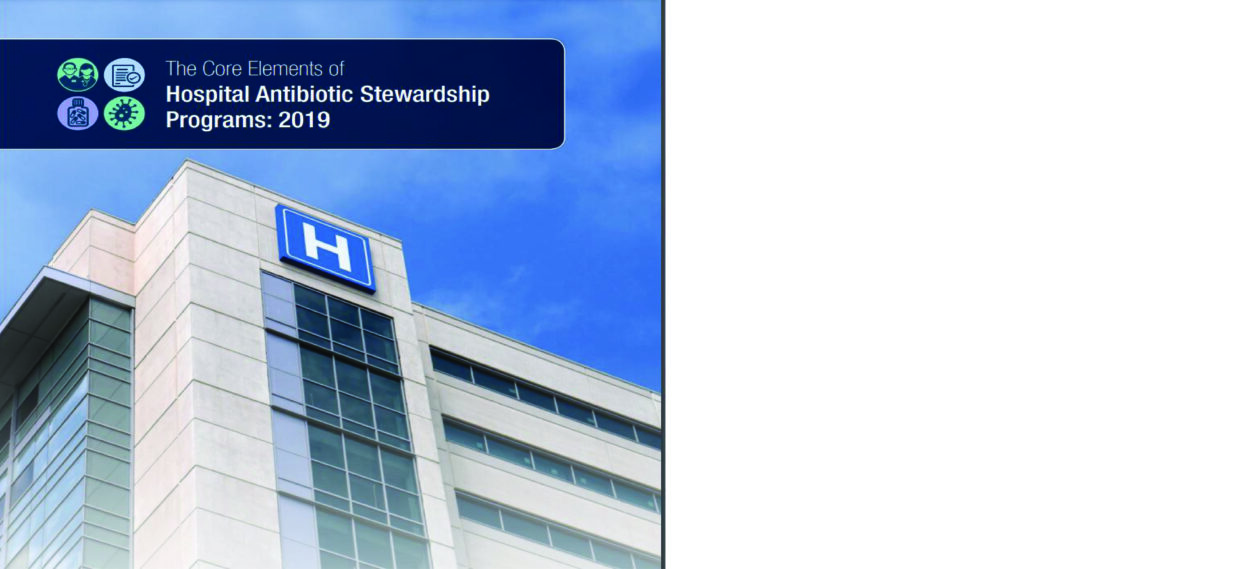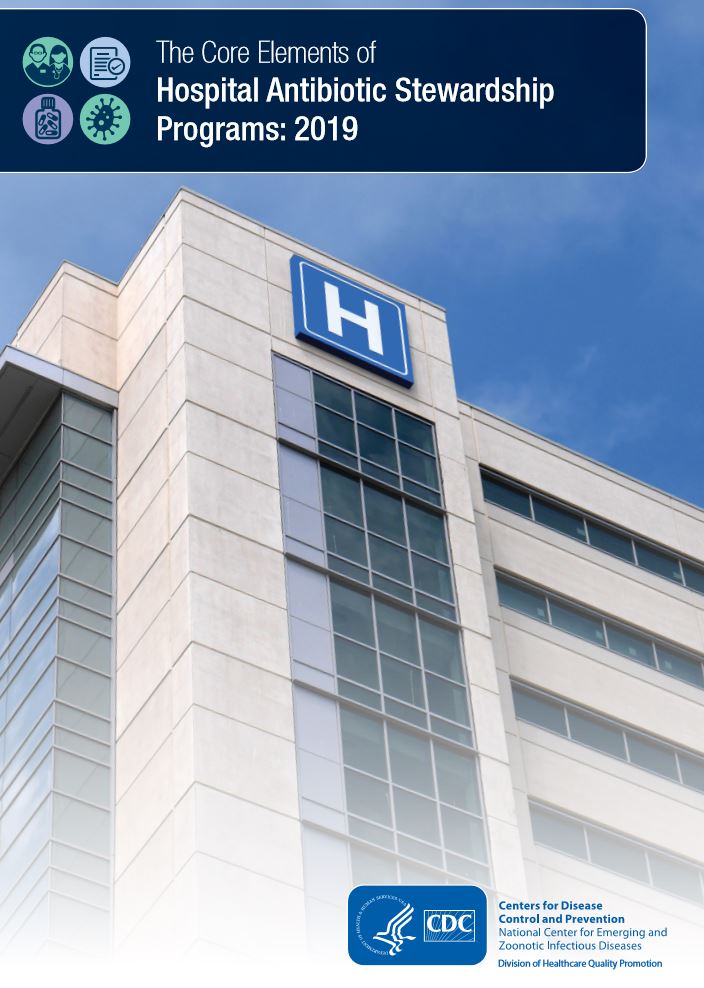CDC Updates Core Elements of Hospital Antibiotic Stewardship Programs

 In November 2019, CDC revised the Core Elements of Hospital Antibiotic Stewardship Programs to provide an updated framework to assist hospitals with implementation of antibiotic stewardship programs (ASP). This revised document incorporate lessons learned and new data in the field of antibiotic stewardship since the initial publication of the previous edition in 2014.
In November 2019, CDC revised the Core Elements of Hospital Antibiotic Stewardship Programs to provide an updated framework to assist hospitals with implementation of antibiotic stewardship programs (ASP). This revised document incorporate lessons learned and new data in the field of antibiotic stewardship since the initial publication of the previous edition in 2014.
In this new document, CDC continues to outline seven core elements of hospital antibiotic stewardship: Leadership Support, Accountability, Pharmacy Expertise (formerly Drug Expertise), Action, Tracking, Reporting and Education. Priority examples are emphasized for the Hospital Leadership, Action and Tracking core elements. Below is a brief description of each core element.
Leadership Support
Support from hospital leaders such as chief medical officer, chief nursing officer, and pharmacy director are critical to the success of hospital ASP. Priority examples include giving ASP leaders the time and resources to manage the program and conduct daily ASP activities, meet with ASP leaders regularly to assess program needs, appointing a senior executive as champion for ASP, and regularly reporting ASP activities and outcomes to senior leadership and hospital board. A list of other leadership commitment examples, such as establishing formal statements of support, are also provided.
Accountability
Hospital ASP must designate a leader or co-leaders to be accountable for program activities and outcomes. The most commonly employed model is the co-leadership of a physician and a pharmacist based on the 2019 National Healthcare Safety Network (NHSN) hospital survey. If this model is employed, responsibilities and expectation should be clearly delineated. For program with a non-physician as program leader, a physician should be designated to serve as support for the non-physician leader. ASP leaders should possess effective leadership, management and communication skills.
Pharmacy Expertise (Formerly Drug Expertise)
Formerly called Drug Expertise, this core element was renamed to reflect the importance of empowering pharmacist to lead ASP implementation efforts. Effective ASP requires the expertise from pharmacists either as leader or co-leader. In larger hospitals and healthcare systems, infectious diseases-trained (ID) pharmacists are highly effective in implementing ASP efforts and improve antibiotic use. In hospitals without the availability of ID pharmacists, general clinical pharmacists with training or experience in ASP has been effective in serving as co-leaders or pharmacy leaders of ASP.
Action
Based on experience and data published in the field of ASP, the CDC now designate prospective audit-feedback (PAF), pre-authorization and implementation of facility-specific treatment guidelines as priority interventions. Antibiotic timeout is now designed as a provider-led useful supplemental ASP intervention.
Prospective Audit Feedback is the review of antibiotic therapy by an expert in antibiotic use (e.g., ID pharmacists or ID physicians) who is not part of the treating team and provision of suggestions on how best to optimize antibiotic therapy. The effectiveness of PAF can be further enhanced through handshake stewardship in which face-to-face discussions occur between providers and a member of ASP.
Preauthorization is the requirement of gaining approval prior to the use of selected antibiotics such as broad-spectrum antibiotics that may be the only options for infections due to multidrug resistant organisms. This approval process allows experts to review the rationale for selecting these agents and provide input on antibiotic selection to optimize therapy and/or prevent unnecessary use. Hospitals should perform their own assessment to determine the antibiotics and/or treatment indications requiring preauthorization, individual responsible for approving these agents as well as other mechanisms (e.g., method of requesting the selected antibiotics) necessary for implementing this process.
Facility-specific treatment guidelines can enhanced the operation of PAF and preauthorization by providing a framework for ASP to establish appropriate and optimal use criteria. Hospitals should prioritize establishing treatment guidelines for the most commonly treated infections in the hospital setting such as lower respiratory tract infection, urinary tract infection, and skin/soft-tissue infection. These guidelines should be based on national guidelines (e.g., ones from the Infectious Diseases Society of America) but customized based on availability of formulary antibiotics, preferred testing strategies, and local antibiotic susceptibilities.
In addition to these three prioritized interventions, CDC also outlined a number of other strategies in four different categories to improve antibiotic use. These interventions include provider-based interventions (e.g., antibiotic timeouts), pharmacy-based interventions (e.g., automatic changes from intravenous to oral antibiotic therapy), microbiology interventions (e.g., selective reporting of antibiotic susceptibilities), and nursing-based interventions (e.g., optimizing microbiology culture by using proper collection techniques).
Tracking
Both the CDC and the CMS emphasize the importance of measuring antibiotic use as an important part of the performance improvement process in antibiotic use and antibiotic stewardship. Measuring how and what antibiotics are used allow ASP to assess impact of interventions and determine if opportunities for improvement exist. CDC recommends tracking three categories of parameters–antibiotic use measures, outcome measures, and process measures.
Hospitals with the technical and financial ability to submit use data through the NHSN Antibiotic Use (AU) Option should use the generated risk-adjusted antibiotic use benchmark (Standardized Antimicrobial Administration Ratio or SAAR) to assess and inform ASP interventions. Hospitals not yet able to submit data to the NHSN AU Option should determine days of therapy (DOT) or defined daily dose (DDD) based on pharmacy and medication administration records. DOT and DDD should be standardized based on patient census (patient-days) to allow comparison over time and between hospitals.
Outcome measures that should be tracked include antibiotic resistance and Clostridioides difficile infection rates. These measures reflect the extent of antibiotic use within an institution and can be impacted by improving antibiotic use through appropriate antibiotic stewardship. In addition, tracking of the financial impact of ASP is recommended to justify resources required for program operation.
For process measures, CDC recommends prioritizing tracking of the types of PAF interventions and acceptance rate, preauthorization interventions such as antibiotics requested for specific indications, and adherence to facility-specific guidelines. Other process measures that can be monitored include the rates of intravenous-to-oral antibiotic conversion and performance of antibiotic timeouts, performance of medication use evaluation to inform opportunities for improvement, and the frequency hospitalized patients are discharged on the correct antibiotics for the recommended duration.
Reporting
Antibiotic stewardship program should regularly report program interventions and tracked measures to prescribers, pharmacists, nurses, hospital leadership and hospital board. Sharing facility-specific findings from medication use evaluations and summaries of antibiotic use can help motivate improvement in prescribing. Sharing prescriber-specific data with peer comparison has been shown to improve antibiotic prescribing in the outpatient settings. However, there is currently a paucity of data on the impact of this type of reporting in the hospital setting.
Education
Education on appropriate antibiotic prescribing is an integral part of a comprehensive program to improve antibiotic use. Education is most effective when coupled with interventions and outcomes. CDC recommends using case-based strategy to provide antibiotic prescribing education such as feedback provided to providers during PAF and preauthorization. Other strategies to disseminate appropriate antibiotic prescribing education include didactic presentations, posters, flyers, newsletters, or electronic communication.
In addition to updating the full Core Elements Of Hospital Antibiotic Stewardship document, CDC also revised the core element checklist to assist hospitals in assessing or re-assessing their antibiotic stewardship program. With more than 80% of hospitals in Nebraska and nationally implementing ASP with all seven core elements published in 2014, CDC will now focus on finding ways and recommending strategies to improve these existing programs.



